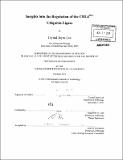Insights into the regulation of the CRL4D̳T̳L̳ ubiquitin ligase
Author(s)
Lee, Crystal Jayne
DownloadFull printable version (11.63Mb)
Other Contributors
Massachusetts Institute of Technology. Dept. of Biology.
Advisor
Jacqueline A. Lees.
Terms of use
Metadata
Show full item recordAbstract
The eukaryotic mitotic cell cycle is a strictly ordered process by which cells accurately duplicate their genome and divide into two. Ubiquitin-mediated degradation of key cell cycle regulators ensures that the cell cycle phases progress in a unidirectional and orderly manner. Cullin E3 ubiquitin ligases (CRLS) comprise a large family of multi-subunit complexes that selectively recruit substrates via a substrate receptor and facilitate substrate ubiquitination and degradation. The CRL4DTL (Cullin 4 RING ligase, in association with the substrate receptor DTL/Cdt2/RAMP) ubiquitin ligase has recently emerged as a key regulator of cell cycle progression and genome integrity. Identified substrates CRL4DTL play critical roles in S phase progression, replication, DNA repair processes, transcription, and chromatin regulation. CRL4DTL_ mediated targeting is restricted to S phase and after DNA damage through a PCNA-dependent mechanism. Recent studies have focused on elucidating the requirements within the substrates that dictate CRL4DTL-mediated degradation. The majority of identified substrates have a specialized PCNA interaction peptide motif (PIP box) that distinguishes the substrates from the stable PIP box containing proteins and couples interaction with chromatin-bound PCNA with CRL4DTL recruitment. Very few studies have explored the regulation of the substrate receptor DTL in the context of CRL4DTL ligase activity. DTL contains multiple WD40 repeats in the N-terminus that are very highly conserved and a less conserved C-terminus that may have important regulatory function. We characterize DTL regulation during the cell cycle: DTL itself is degraded in an ubiquitin-dependent manner and degradation is dictated by an unidentified C-terminal determinant. DTL is also phosphorylated in the C-terminus. Here, we present the first study to directly examine the contribution of the C-terminus to CRL4DTL ligase activity in the context of live cycling mammalian cells. We find that the DTL N-terminus can interact with substrates whether or not the substrates have bound PCNA. Importantly, we find that elements within the C-terminus are not required for CRL4DTL ligase assembly, substrate recognition, and substrate degradation during S phase and after DNA damage.
Description
Thesis (Ph. D.)--Massachusetts Institute of Technology, Dept. of Biology, 2012. In title on title page, double-underscored "DTL" appears as superscript. Cataloged from PDF version of thesis. Includes bibliographical references (p. 131-140).
Date issued
2012Department
Massachusetts Institute of Technology. Department of BiologyPublisher
Massachusetts Institute of Technology
Keywords
Biology.